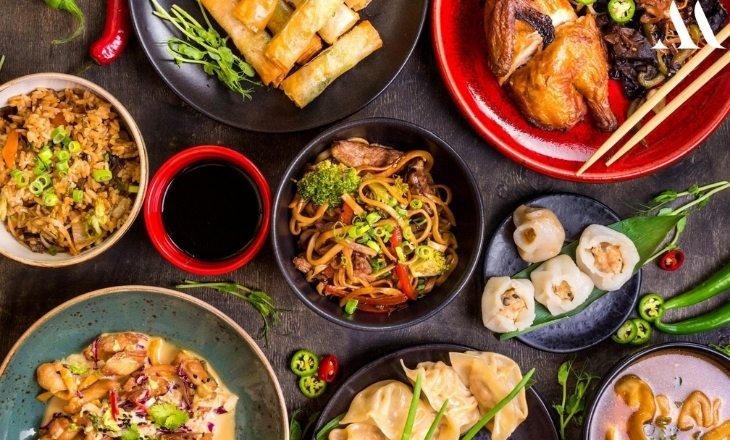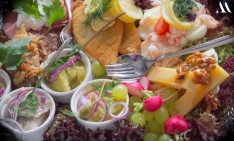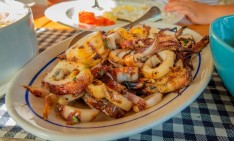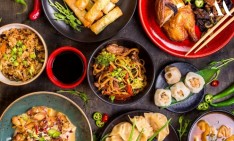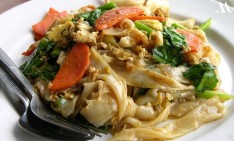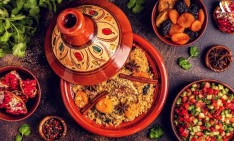China is a historic country with an ancient culture and age-old traditions. It is geographically a large country with diverse terrain and climatic conditions. Hence, it also has diverse produce, and this translates into a variety of cooking styles. Chinese cuisine is further classified into eight regional cuisines. The emergence of these sub cuisines was based on their geographical locations, such as Anhui, Guangdong, Sichuan, Hunan, Jiangsu, Fujian, Shangdong and Zhejiang.
After China's brash and bright cities, the fresh mountains and well-preserved villages of the Anhui region bring calm and peace. The granite cliffs of Huangshan and the peaks of Jiuhua where Buddhists bless the souls of the departed are wonderful to soothe the senses. The Luo Dongshu temple in the Anhui region’s Chengka is an ancient wooden temple complex that took 71 years to build.
The Anhui cuisine of Eastern China is considered to be healthy and visually interesting with simple flavours. Anhui cuisine is characterised by ample use of fresh herbs, mushrooms, berries, tea leaves, bamboo shoots and other wild plants that grow in the region surrounding Huangshan Mountain. Dishes are prepared mainly by braising and stewing in a way that preserves the nutrients of the food. Soft-shelled turtle stew, bamboo shoots with dried mushrooms and stinky tofu are some famous dishes of Anhui cuisine. The food here is seen as therapy.
The Guangdong or Cantonese cuisine is the cuisine of Southern China. It is said that people from here eat anything that walks, crawls, flies or swims. Cantonese cuisine is influenced by both Oriental and Western cooking traditions. Cantonese dishes are very flavourful as they use varied ingredients like cassia bark, liquorice root, dried tangerine peel and rice wine.
The methods used to prepare Cantonese dishes are sometimes quite unconventional and include salt-roasting, steaming with wine and slow-cooking, which are just a few of the 21 cooking methods used here. The most famous Cantonese dishes include The Dragon and Tiger Fight, Hong Kong egg custard tarts, wontons, and spring rolls.
While you feast on Cantonese dishes, do visit Shamian Island and stroll around the foreign settlement built in the 19th century and enjoy the sights of old churches, cathedrals and embassies. Do not miss out on visiting the Guangzhou Opera House. Watching an artistic performance, such as an opera, ballet, drama, symphony concert, Beijing opera, or local Cantonese opera, in this opera house is an amazing experience. This region is also home to the largest Catholic cathedral in China, the Sacred Heart Cathedral. Make your visit to Guangzhou truly memorable by cruising along the Pearl River.
Sichuan cuisine is mostly identified as hot and spicy, but it has six culinary cognitions - numbing, spicy, sweet, salt, sour, and bitter. The main seasonings include chilli and garlic, as well as locally produced Sichuan pepper. Sichuan cuisine makes big use of freshwater fish and also your typical chicken, duck, and pork meats. Shark fins, bear paws and other unconventional ingredients are also used. The most popular Sichuan dishes include Kung Pao Chicken, Twice Cooked Pork and Tea Smoked Duck.
Sichuan region is highly ranked for cultural and historical significance. It also offers breathtaking natural parks and wildlife. Jiuzhaigou Park is easily one of the most beautiful in the world. Dragon Lake, Pearl Shoal and Nuoriliang Waterfall are some of its most popular and most breathtaking attractions. The Baoguo Temple in the remote valley of Lingshan is over 970 years old and is an active temple for practising Buddhist Monks. The Lehsan Buddha in Sichuan is the largest stone Buddha sculpture in the world and has been listed as a UNESCO World Heritage Site.
Hunan in southern China is dominated by rolling hills and beautiful valleys, which provide a fertile ground for growing a wide range of crops, especially rice. Hunan cuisine is famous for its spiciness, deep colours and fresh aromas. Chilli is valued highly in Hunan province. Dishes are oily and dark-coloured, with spicy, sour and mellow flavours.
Smoked and cured foods are typical in this part of the country. The main cooking techniques include braising, stewing, smoking and steaming. Typical ingredients include scallions, chilli and pepper. The most famous Hunan dishes include Dong'an Chicken, Chopped Pepper Fish Head, Crispy Duck, Orange Beef and Spicy Frog's Legs.
Hunan offers scenic mountain vistas, and charming far-flung villages and local life. The capital city of Chengsa has vibrant nightlife and street food. The cable car ride to Tianmen Mountain is said to be the longest in the world. Other attractions on Tianmen mountain include a hilltop Pagoda (Fairy Peak), a second cable car, a Buddhist Temple (Tianmenshan Temple), a glass walkway, and Tianmen Cave. This region is also home to Phoenix Ancient City, a historical Chinese riverside city surrounded by hills and steeped in old Chinese charm.
Jiangsu cuisine, also known as Su cuisine and its subgroup Huaiyang is claimed as one of the top traditional cuisines of China and very popular amongst the imperials. Jiangsu cuisine is known for its light and fresh taste. It uses various ingredients that are judiciously selected for each particular recipe and includes many fresh and live sea ingredients. Other widely used ingredients comprise tea leaves, mushrooms, and bamboo shoots, but the seasonings and spices are limited in their usage. Cooking methods are mostly stewing, quick-frying, braising, stir-frying to make it aromatic and slightly sweet and salty. Jiangsu is a coastal province, and therefore, fish and a variety of seafood feature prominently in their cooking and pork. Well-known dishes in Jiangsu cuisine are Jinling salted dried duck, clear crab shell meatballs, and Yangzhou steamed Jerky strips. A prominent dish of Su cuisine is Squirrel shaped Mandarin Fish. The majority of Jiangsu dishes are prepared by adding lotus root, Chinese chestnuts, water bamboo, and water chestnuts.
While visiting Jiangsu province, do visit the Confucius Temple in Nanjing. Also situated in Nanjing is the Ming Xiaoling Mausoleum, the Hongwu Emperor's tomb, the founder of the Ming Dynasty and renowned for his extraordinary political reforms. The mausoleum's construction began at the foothills of the Purple Mountain in 1381 and ended in 1405, incurring massive expenditure that involved 100,000 labourers. In the later centuries, the mausoleum suffered much damage, but originally the wall of the mausoleum was more than 22.5 kilometres long, and today it is listed as UNESCO’S World Heritage Site.
Do try to take a boat cruise down the Grand Canal, the world’s longest man-made waterway at 1800 kilometres. Another quaint sight is the Zhouzhuang Water Town, which lies between Shanghai and Suzhou. It is an ancient town of Kunshan City, Jiangsu Province, which flourishes with lakes and rivers. It is considered by many as the best waterside town in China.
Fujian cuisine, also known as Min cuisine, is native to the Fujian Province. This south-eastern Fujian coastal area yields 167 varieties of fish and 90 types of turtles and shellfish. It also produces edible bird's nest, sturgeon and cuttlefish. These special products are widely used in Fujian dishes. The distinguishing feature of Fujian cuisine is that the dishes are served in soup. The cooking methods are stewing, boiling, braising, quick-boiling, and steaming. Fujian cooking also involves a careful selection of seafood and corresponding ingredients giving the dishes a beautiful colour and magical taste of sweet, sour, salty and savoury. Focus is laid on the cutting skills of the seafood and other ingredients to achieve the true flavour. In Fujian cuisine, an important sweet and sour flavouring and colouring material is red distiller's grain. It made of rice fermented with red yeast that is aged for a year. Poultry, seafood, pork and vegetables can be flavoured with red grain.
A very famous dish of the Fujian cuisine is very aptly named Buddha Jumping Wall. It is made with 28 ingredients like abalone, sea cucumber, fish stomach, ham and mushroom, which are added to a jug along with Shaoxing wine, sealed with mud and then simmered for ten hours. When the jug is opened to serve, the aroma that wafts out is said to be tempting enough for the Buddhists to give up praying and jump over to taste it. Hence, the name. Fishball soup, Spring rolls and Steamed Chicken in Red Fermented Rice are some trademark dishes of this region.
Wuyi Mountain is known for the natural beauty of its cliffs and waters. The average height of the peaks is over 1000 meters above sea level. It is also known for being of great historical and cultural value. The Xichan Temple, located just beyond the Fuzhou University, was built in 867 AD during the Tang dynasty. The temple boasts of a collection of jade statues of Buddha brought from Myanmar.
Gulangyu, or 'Piano Island', is a car-free island southwest of Xiamen. Among the many attractive spots on this tranquil island, the most beautiful are Sunlight Rock and the Shuzhuang Garden. It is also renowned for its beaches and winding lanes.
Shandong cuisine is liked for the many different seafood and vegetable dishes for its salty, with a prevalence of light-colour sauces. Their method of frying in high heat that seals in the flavours and isn't oily. The chefs prefer to cook meat and vegetables in a wok over a big hot flame by bringing the oil to a boiling point at an extremely high temperature, then toss in the main ingredients first. This immediately sears the outer layer and traps in the flavour, and later spices are added to it for a quick fry. It also prevents oil from seeping into the food. This cooking method is called "bao."
Shandong is the main wheat-growing area in China, and wheat-based dishes form a staple cooking. Shandong people often prepare big cakes stuffed with scallions or minced meat for their meals. Dezhou Stewed Chicken, Chicken balls in Milk Soup, Braised Sea Cucumber and Four Happy Meatballs, a dish made during Chinese New Year, are some typical dishes of Shandong cuisine.
The Terra Cotta Warriors Of WeiShan is the 3rd largest, displaying a collection of 8000 life-size pottery models of soldiers, servants, war carriages, horses, jugs, pots, and other artefacts of the Han Dynasty. This is found on the hillside of the Weishan Scenic Area of Shandong province. Mount Tai is a sacred mountain located in central Shandong Province, spanning the border of two regions (Tai'an and Jinan). It is ranked first among the Five Great Mountains of China. Zhoucun Ancient City is situated in Zibo, Shandong Province. Zibo is known for its silk, sesame and ceramic products. Its historical commercial streets were trading grounds where traders had built their offices, but eventually, the offices were turned into shops and museums. A newly added attraction to the tourist circuit in Shandong is the Qingdao Beer Festival. Since 1991, Qingdao Beer Festival has successfully held 22 beer carnivals. It begins from the second weekend of August every year and lasts for three weeks. There’s a variety of food, both Chinese and Western and beers on tap from around the world. The festival is the largest of its kind in Asia and brings people together, uniting elements of tourism, entertainment, culture, leisure, and trade.
Zhejiang cuisine also called Zhe Cai, comprises food from four regions - Hangzhou, Ningbo, Shaoxing and Wenzhou. Hangzhou cuisine is famous for its extravagant preparation and different techniques of cooking, such as sautéing, stewing, and stir- and deep-frying. West Lake Fish in Sweet Sour Sauce, Dongpo Pork, Beggar's Chicken, Fried Shrimps with Longjing Tea, Sister Song’s Fish Broth, Beancurd with Eight Delicious and Hangzhou Soy-sauce Duck are some of the widely served dishes.
While Hangzhou food tastes fresh and crisp, the Ningbo cuisine cooking style retains the original freshness, tenderness and softness. Crystal Sugar Turtle, Dry Fried River Eel, and Yellow Croaker with Sea Cucumber are some of the signature Ningbo cuisine.
Shaoxing cuisine further subdivided into Mei Dish, Salted Dish and Smelly Dish. Mei Green Vegetable, salted vegetables and meat like pork, chicken, duck, etc. and Stinky Tofu are favoured by Shaoxing people. Predominant ingredients are fresh river food and poultry that has a special rural flavour. The dishes are slightly fragrant and cooked with mild Shaoxing rice wine.
Zhejiang Province is renowned for its scenic mountain and water scenery. The Orchid Pavilion in Shaoxing City, Zhejiang Province, famed for its history and stylish garden views, is an important site for Chinese calligraphy and is devoted to Wang Xizhi, the sage of calligraphy.
Qiantang River is the largest river in Zhejiang Province, running along a total length of 494 kilometres. The Tidal Bore of the Qiantang River is a spectacular sight, and it is the world’s largest - up to 9 m (30 ft) high, travelling at up to 40 km/h!
Situated in the southeast of Zhejiang Province, Yandang Mountain is one of China's 10 most famous mountains, famed for its unique landscape. Stretching across a total area of 450 square kilometres, the mountain includes over 500 tourist spots, all scattered across its eight major scenic zones. The region is mostly composed of peaks, waterfalls, caves and steep cliffs. Among all the spots, the best is Lingfeng Peak (The Spiritual Peaks), Lingyan Rock (The Spiritual Rocks) and Dalong Qiu (The Big Dragon Waterfall), known as the "three perfections of Yandang Mountain."
To take an Oriental experience with culinary experimentation on your mind, talk to us at Metanoia!
| Tags ~ Chinese regional cuisine, World famous Chinese dishes, Most famous Hunan dishes, Famous Anhui, Guangdong, Sichuan, Hunan, Jiangsu, Fujian, Shangdong and Zhejiang regional cuisines, food and travel in China |
.png)

